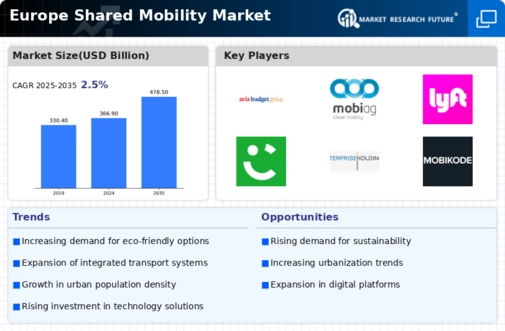Europe Shared-Mobility Market Summary
The Europe Shared Mobility market is projected to grow from 366.9 USD Billion in 2024 to 478.5 USD Billion by 2035.
Key Market Trends & Highlights
Europe Shared Mobility Key Trends and Highlights
- The market is expected to experience a compound annual growth rate of 2.44 percent from 2025 to 2035.
- By 2035, the market valuation is anticipated to reach 478.5 USD Billion, indicating robust growth potential.
- In 2024, the market is valued at 366.9 USD Billion, reflecting a strong foundation for future expansion.
- Growing adoption of shared mobility solutions due to increasing urbanization is a major market driver.
Market Size & Forecast
| 2024 Market Size | 366.9 (USD Billion) |
| 2035 Market Size | 478.5 (USD Billion) |
| CAGR (2025-2035) | 2.44% |
Major Players
Avis budget group (U.S.), car2go NA, LLC (U.S.), Beijing Xiaoju Technology Co, Ltd. (China), Mobiag (Portugal), Movmi Shared Transportation Services Inc. (Canada), Uber Technologies Inc. (U.S.), ANI Technologies Pvt. Ltd. (India), Lyft, Inc. (U.S.), Careem (U.A.E), Bolt Technology OÜ (Estonia), HERTZ SYSTEM, INC. (U.S.), Aptiv (Ireland), Enterprise Holdings Inc. (U.S.), MOBIKO (Germany), Curb Mobility (U.S.), BlaBlaCar (France), Wingz (U.S.)


















Leave a Comment